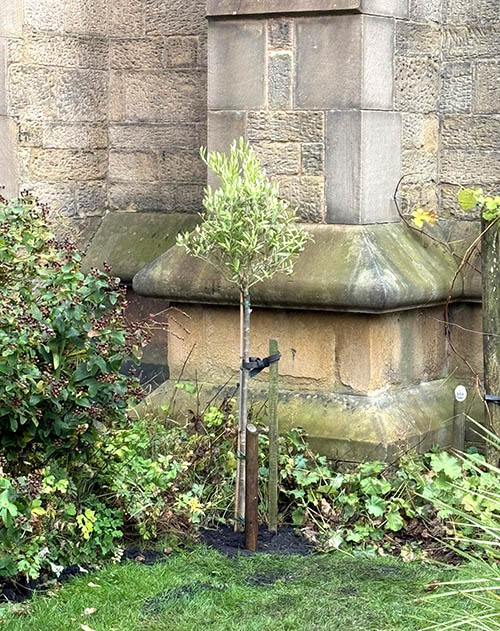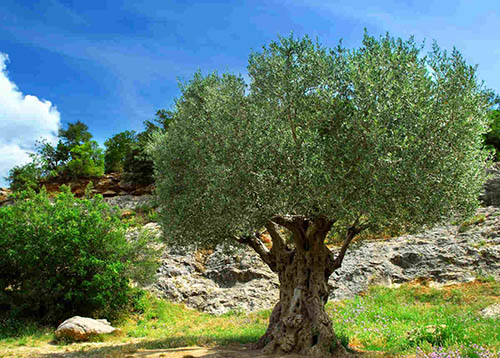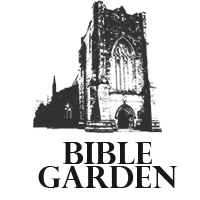Olive Tree (Olea europea)
Map Position: 25The olive tree has been cultivated for over seven thousand years. It can live for more than a thousand years and there is one in Greece that is around 3500 years old. Today there are about two million olive groves in Europe alone.
It is mainly found in the Mediterranean, Near East and South Africa. It is the most important tree in this area and in human civilisation in general: its fruit can be eaten whole, it can be cooked, preserved in brine, used to make dye, oil etc, its wood is used for furniture, chopping boards and carving, for building, for charcoal and as firewood.

The oil is used
- for cooking, (and is said to be the best and healthiest oil you can get),
- as medicine,
- as cosmetic for skin and hair care,
- to anoint, bless and honour kings, prophets and priests and other important officials
- as source of heating and lightning.
In symbolism it is important from antiquity to the present day:
- the olive branch is a sign of peace and friendship,
- winners in the Olympic Games were crowned with the victorious wreath made of olive branches
- the olive tree had its own god: Aristaios
- the seal of the United States of America shows an eagle holding an olive branch
- the flag of the United Nations depicts a globe surrounded by olive branches.
Biblical
In Hebrew, the “Messiah” is “the Anointed One”, in Greek the “Christos”.
The importance of the olive tree and its fruit for day-to-day life and culture is reflected in the enormous number of the references in the Bible from the Genesis in the Old Testament to the Revelation in the New Testament:
When the waters receded after the Flood, Noah sends out dove and “in her mouth was a freshly plucked olive leaf” (Genesis 8.11). Hence, the olive branch has been seen as a sign of peace ever since.
In Exodus the Lord gives Moses detailed instructions on how to build an altar, how to appoint priests and carry out the religious rites and olive oil is always indispensable.
For His altar the people of Israel are to bring Moses “pure beaten oil for the light, that the lamp may regularly be set up to burn” (Exodus 27.20).
For the light that had to “be kept burning regularly” Moses had to use “pure oil from beaten olives” (Leviticus 24.2, see also 9. Fig).
God leads the Jews “into a land, […] a land of olive trees” (Deuteronomy 8.8). But there is a stark warning: if the Jews disobey the Lord, He will sanction them, and their plantations will not bear fruit: “You will have olive trees throughout all your territory, but you shall not anoint yourself with the oil, for your olives shall drop off” (Deuteronomy 28.40).
Jotham who was denied his right to be king used a parable of useful trees including the olive tree which should not have the bramble as their king to explain that he should be the ruler (Judges 9.8 and 9).
Through Samuel God tells the people to be wise when choosing a king, because a king can easily become a dictator; he could “take the best of your fields and vineyards and olive orchards” (1. Samuel 8.14).
When King David was under pressure, he “went up the ascent of the Mount of Olives” to reflect, and teach all his people (2. Samuel 15.30).
Olive wood is a very valuable building material which is used for the temple (1. Kings 6.23, 6.31, 6.32, 6.33).
The prophet Elisha had healed a rich leper without asking for any payment, including accepting the offer of olive orchards. But one of Elisha’s servants went after him to demand some payment pretending to act in Elisha’s name. When Elisha heard this, he made “the leprosy cling to” him (2. Kings 5.26).
It is a sign of peace, when everyone can live on his own “land of olive trees” (2. Kings 18.32, see also 9. Fig).
Olive trees are among the king’s treasures (Chronicles 27.28, see also 7. Sycamore).
When “the nobles and the officials” exploited the poor people and confiscated their positions Nehemiah the prophet ordered them “Return to them this very day their fields, their vineyards, their olive orchards, and their houses, and the percentage of money, grain, wine, and oil that you have been extracting from them” (Nehemiah 5.11).
During the holy time of the Feast of the Tabernacles, people of Israel should dwell in booths, made among others of “branches of olive, wild olive” (Nehemiah 8.15, see also 17. Palm).
The Jews acknowledge that it was the Lord who gave their forefathers the rich land of the Canaanites with “houses full of all good things, cisterns already hewn, vineyards, olive orchards and fruit trees in abundance” (Nehemiah 9.25).
The fate of the one who does not fear the Lord is bleak, and described in a parable that everyone at the time would understand: he will “cast off his blossom like the olive tree” (Job 15. 33). And all his efforts will be in vain, and his olives will not bring harvest. (Job 24.11).
The olive tree is used as a parable of strength and reliability: “I am like a green olive tree in the house of God. I trust in the steadfast love of God forever and ever” (Psalm 52.8).
You should fear the Lord, and you will be blessed; a parable that everyone in Israel understands is used: “Your wife will be like a fruitful vine within your house; your children will be like olive shoots around your table” (Psalm 128.3).
Gleaning is an important part of harvest and a parable about it is well understood as about the predicted fall of Damascus (Isaiah 17. 6) and the end of earth (Isaiah 24.13).
The Lord will take care for His people and provide them with all they need: “I [God] will put in the wilderness the cedar, the myrtle, and the olive. I will set in the desert the cypress, the plane and the pine together” (Isaiah 41.19 – see also the other trees mentioned here).
When the house of Israel worshipped other gods, the Jews were reminded of who made them prosperous and without God’s blessing they will lose everything. “The Lord once called you ‘a green olive tree, beautiful with good fruit’. But with the roar of the tempest, he will set fire to it, and its branches will be consumed” (Jeremiah 11.16).
When Israel returns to the Lord after sinning, its “beauty shall be like the olive” (Hosea 14.6).

The destruction of fruit trees and especially olive trees is God’s punishment for the sinful life of the Jews (Amos 4.9 and Micah 6.15, see also fig).
The prophet tells us to rejoice in the Lord, even “though the fig tree does not blossom, nor fruit be on the vines, the produce of the olive fails” (Habakkuk 3.17) because “God, the Lord is my strength” (Habakkuk 3.19).
When the Jews had returned from their exile in Babylon, they were encouraged by the prophet Haggai to rebuild their lives and especially the temple: “Is the seed yet in the barn? Indeed, the vine, the fig tree, the pomegranate, and the olive tree have yielded nothing. But from that day on I will bless you” (Haggai 2.19).
Zechariah was awakened the middle of the night by an angel. He had a vision of a lampstand and “there are two olive trees by it” (Zechariah 4.3). As Zechariah did not understand “What are these two olive trees on the right and on the left of the lampstand” and “What are these two branches of the olive trees” the Lord explained that “These are the two anointed ones that stand by the Lord of the whole earth” (Zechariah 4.11 &12).
Zechariah announces the day of the coming of the Lord: “On that day his feet shall stand on the Mount of Olives that lies before Jerusalem on the East and the Mount of Olives shall be split in two” (Zechariah 14.4).
Jesus triumphantly enters Jerusalem passing by “the Mount of Olives” (Matthew 21.1 and Mark 11.1).
Jesus “sat on the Mount of Olives” when he taught the disciples “of the end of the age” (Mathew 24.3 and Mark 13.3), and Peter’s denial (Mathew 26.30 and Mark 14.26).
Jesus prayed at “a place called Gethsemane” which can be translated as “Place of the Olive press” (Mathew 25.36, Mark 14.26 and 14.32).
Luke also tells us of Jesus’ triumphal entry into Jerusalem “at the mount that is called Olivet” (Luke 19.29), Jesus rode on a colt “on the way down to the Mount of Olives” (Luke 19.37). Jesus “lodged on the mount called Olivet” (Luke 21.37 and John 8.1), and he prayed there (Luke 22.39).
After Jesus’ death, the disciples “returned to Jerusalem from the mount called Olivet” where they chose Mathew to replace Judas (Acts 1.12).
Paul in his letter to the Romans explains the relationship between Christians of Jewish and non-Jewish origin using an Olive tree that has been grafted: both the roots and the branches have value (Romans 11.17 – 24). Paul could be sure that the Romans would understand a parable with an olive tree.
We can use our mouth to speak blessings and evil things. But only a good person will use his mouth to say only good things, just as a fig tree will not produce olives (James 3.12, see also 9. Fig).
The “two olive trees and the two lampstands that stand before the Lord of the earth” from Zechariah’s vision are mentioned in the New Testament as well (Revelation 11.4)
